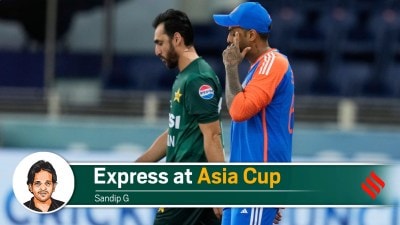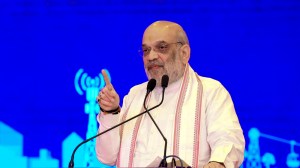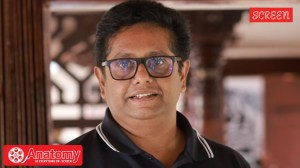Craig Fulton at Idea Exchange: ‘One of the bigger problems in India is hierarchy. I don’t subscribe to that’
After being an assistant coach for Belgium, arguably the best team of the last decade, he’s taken over an Indian team that returned to the Olympic podium after over four decades.
 CRAIG FULTON, hockey coach, india (File Photo)
CRAIG FULTON, hockey coach, india (File Photo)The India hockey coach on preparations for the Paris Olympics, getting the players to share their stories as a part of team-building process and understanding the country’s caste system and its impact on individual performances. The session was moderated by Mihir Vasavda, Senior Assistant Editor, The Indian Express.
Mihir Vasavda: Is there a nice way of breaking the news to a player that he won’t be in the team for the Olympics? How do you handle emotions?
It’s the worst part of the job. When you have a group of guys, you create synergy and trust within your squad. We started with 39 players (in the camp). Then (reduced it to) 29, 27, now it’s 24, soon it’ll be 19 and then it’ll be 16. So it’s not easy. That’s why the Olympics are the pinnacle of our sport. Not everyone gets to go. It’s a bonus if you do well.
There are so many variables that can happen. You try to prepare for every single eventuality; injury-wise, tactics-wise, players that get injured in the game, then who can cover and how you can still play your same rhythm, tactics and style even if you lose a player or two. So yeah, it’s difficult.
For the World Cup, the selection is of 18 players including two goalkeepers. At the Olympics, it’s 15 and one goalkeeper, so 16. Then there are two non-travelling players and one goalkeeper that stay outside the village but you still need to create that family environment. I think 20-30 per cent of the time, players get injured and you need to use either the 17th or 18th player. Seldom does the goalkeeper get used but the other players, definitely. You don’t know when it’s going to happen but it’s possible, so you need them in the right frame of mind to ensure they haven’t shut off.

That 17th or 18th player could be the key for a team to be very successful. That happened with Belgium. We were in the World Cup and two players got injured. The stand-bys came in and went all the way and won the tournament. It’s a massive part of the success if you can do it right.
Mihir Vasavda: Everyone has their insecurities and ambitions, especially at a time like this when the team is getting selected. So how is the mood in the camp?
We are humans, not robots. It’s not just about equipping each other with the right tools but also about having a platform where you can open up and say ‘I am struggling with this’. We have a circle of trust going around pre-match, and post-competition. If you are struggling with something, speak. From a staff point of view, from a player-to-player point of view, there really needs to be a bridge of trust. It works well. The tour to Australia (in April) was tough and there was feedback post-games there. Paddy (Upton, the sports psychologist) was there and we did some good work in that space. The mood is exciting.
On Hierarchy: The more junior you are as a player, the less say you have. I have tried to crack that wide open. of course, you need seniors but you want a safe space where players can share without any worries
Sriram Veera: In your first team meeting, you drew an India map, asked the players where they are from, and you populated that graph accordingly. What was the reasoning beyond the obvious?
(Shows his laptop wallpaper where that graph is). Players come from all over; from Punjab, Manipur, Kerala, and South; it was interesting to work out what was their story, how they got into hockey, who went to the same academy, who has played junior-level hockey together, who hasn’t. How did they come into hockey — was it family-based or are you an outlier spotted for your talent?
With that kind of deep information, I can know who connects with whom, the common grounds, the language challenge — who has had to learn Hindi, who speaks naturally. India’s strengths are its various cultures, dialects and diversity. If I don’t understand that melting pot, I am lesser of a coach. It took time but it was fascinating.
I also had a language challenge with some but we did a value-based exercise — how they wanted to play, how they wanted to be viewed, how they wanted to act in achieving that — it was done in three different languages. Everyone connected with that.
So it was fruitful and interesting not just for me but for them. Someone like Sreejesh was impressive; he comes from Kerala, down in the south — isolated if you consider the regular pockets of hockey in the country. It’s interesting how he had to move around, adapt, and be so inspiring to the group.
On future plans: We are looking to connect how the U-21s play compared to how the seniors play. The same terminology, training, drills and then you allow the new U-21 head coach to put his own spin on it. That’s the succession plan
Sriram Veera: You also delved into the castes involved and were curious about learning that early on. What is the reason behind that?
Coming from South Africa, it’s a rainbow nation and you can say the same thing about India. I grew up in Apartheid and I didn’t even know the details. In ’84, when I moved from Zimbabwe to South Africa, I wasn’t any wiser about this stuff. When Nelson Mandela was released, I was in high school and played in a tournament when he was released. Growing up in the political system, you learn. We played the 1996 Olympics in Athens and our team was pulled out in 2000 due to political reasons. We had qualified, we were going, and we kept the same team from ’96 but we got pulled out as we didn’t have enough players of colour. How is that normal? It brought big changes in the country — right or wrong. I was too young to understand.
I look at it now: India’s caste, South Africa’s white-black — it’s all human. It was important to understand all this.
But one of the bigger problems in India (hockey) is that of hierarchy. The more junior you are as a player, the less say you have. I don’t subscribe to that. If that’s the case, you are in a flawed system. I have tried to crack that wide open: of course, you need seniors but you want a safe space where players can share without any worries. That we have achieved from my side and also from seniors, which is great.
On India’s diversity: India’s strengths are various cultures, dialects and diversity. If I don’t understand that melting pot, I am lesser of a coach. It took time but it was fascinating
Story continues below this ad
Amit Kamath: When you first joined Hockey India as coach, what were the things that stood out in contrast to Belgium. Did you spot a difference in the team culture or the way things are done in the two countries? Were there any similarities?
The number one thing that stands out is that there is no league in India. From a collective point of view, Europe is fuelled from a family club environment where clubs are well supported from juniors to whoever plays in the fifth, sixth, seventh or 20th team or whatever it is. In India, it’s quite isolated as the senior squad and the U-21 team train all year round for competitions. There are the National Games or the National Championships. That would be the
league environment.
What happened in the past was that Hockey India League came in and helped get that youth into competitions with international players from the rest of the world. I’m glad that’s coming back, as it will be helpful for Indian hockey to have more competition outside of just international competition. The legacy that Indian hockey has is very different from the legacy that Belgium hockey has. It’s just a different story. For the last 10-12 years, Belgium has put a lot of emphasis on… from not qualifying to being consistent in qualifying for all the Olympics and then going from London 2012 to Rio 2016 and from there to Tokyo 2020. So that was a big improvement.
But at the same time, if you look at India’s track record, from finishing last in London 2012 to eighth in Rio de Janeiro to medalling in Tokyo 2020, it’s been a very impactful period and the investment’s been in the right place.
The coaching has been done well. The investment in strength and conditioning and training facilities in SAI Bengaluru was done well. That showed on the pitch. We’re in that same space. Although India is really fanatical about its hockey, it’s taken a while for them to be competitive in the modern era again because of astroturf and sports science. It takes time to create consistency in any high-performance programme. And you’re still not guaranteed a win. Look at Australia. The last time they won a gold medal at the Olympics was in Athens in 2004. They win all the World Cups or they come close to it or they’re competing. But they’ve had a dip. At the same time, they’re still very competitive. If you meet them in the quarters of semis, it’s still not an easy game. It’s tough to be consistent and tough to peak for the Olympics and the World Cups.
On the mood in the team: We are humans, not robots. it’s not just about equipping each other with the right tools, it’s also about having a platform and saying, ‘i am struggling with this’. We have a circle of trust
Vinayakk Mohanarangan: How did you see the 0-5 series defeat in Australia? In four matches, you had your chances to win or draw, but ultimately India didn’t win any. Do you detach from results in such cases?
We wanted a tough competition before the Pro League because, otherwise, we’re just going to train and play ourselves. That’s not going to be helpful. The other thing is we need to build the depth of our squad. So, if we lost a key player in every line, how would we perform? Who would be ready to play and how? We had a squad of 27 over five games. We played everyone and also handed a debut to Boby (Singh Dhami).
It was more of a focus on squad depth through good competition. And then we would find out more about ourselves, and what we needed to do well while playing against Australia. But if we played Australia, it would help expose some parts of our game that were really good or weren’t. I think we got the benefit of both.
Our deep defence was very good. Sometimes, Australia can get the better of you by five, six, seven goals. In the first game, like I said, we weren’t there. It was a little bit of a mismatch on the day from our point of view. The other games were good but unfortunately, we couldn’t get over the line.
We learned a lot. I was pleased about the competition, but even more pleased about the depth in the squad and covering different positions.
Vinayakk Mohanarangan: When India is playing, there seems to be a crucial match-costing mistake around the corner. How do you address that?
You are always one mistake away from conceding a goal? At the same time, you hopefully don’t make the last mistake, hopefully creating enough pressure to put the opposition into that situation where they make the last mistake.
And the beauty of it is if we can learn those lessons. And I know that the coach and coaching staff know how to fix it. It’s not like it’s an impossible fix. The more we can learn that lesson, the more we put it into practice. Once the selection is done and we are playing the chosen team in those different positions, we are really prepared for that situation. Once we’ve gone through all of this, made a few mistakes, really gone down to our final selection, then we have the players who can deal with those situations. You need good players to win, but you can also lose with good players.
Tushar Bhaduri: Does India’s hockey medal at the Tokyo Olympics, which came after such a long time, increase the pressure on you?
To be perfectly honest, for any team to win a medal in Covid is an exceptional achievement. It’s not normal what everyone went through at that time — preparing for Olympics, the delay of a year, and everything else they went through. So, I won’t say it’s pressure, it’s more about the focus. Realistically, every time we play in a competition, we want to win. That’s my philosophy.
But there’s also a realistic goal and an ideal goal. The ideal goal is to win gold in every tournament we play. Realistically, it’s where you are ranked now, and how you are performing. That’s where the next block of Pro League games comes in. We took a knock with the Australia results (India lost the five-match series in Perth 5-0), but that’s a different scenario because that wasn’t on tournament basis, it was a one-off series.
In this tournament environment that we have now, we have video referrals, we have everything that we would be accustomed to in the Pro League. At the same time, we want to win a medal, we want to play up… We are, I think, ranked fifth or sixth at the moment, so there’s a bit of room in getting into the top 3, and we are looking at the next seven weeks and obviously, after this Pro League, to know exactly where we stand and what we need to improve to be very competitive in our pool. So, the bottom line is that we want to do as well as we can, we want to win this competition. But realistically, where are we now? We are a little bit behind, but we have eight games in the Pro League to understand where exactly we stand, and from that point of view, I can answer this question post these
eight games.
Pratyush Raj: In recent times we have seen our forwards struggling to score goals. Where do you think they can improve?
That’s difficult because a lot of the teams are playing lower (block) now. They are putting nine and 10 players in and around the 25 (metre, defensive third). You have less time in the D to turn and shoot because of the zonal elements but that’s been there for the past maybe five or six years. The Indian teams have scored goals in those periods. It is just about the chemistry between the players and also the mindset of the players when they are getting into the D, they are full of confidence.
Everyone tries to shoot, everyone tries to connect in the nine-yard area. There is a lot going on in the final third. There are challenges if you are making mistakes at the back in the penalty corner and then upfront if you are making a mistake, it changes the dynamic of the game. The forwards are connected and trying to get as many outcomes as possible and enjoy doing it. We are trying to convert field chances to goals and certain teams play low, certain teams don’t. We are trying to get the right combinations that suit all the strikers.
Nitin Sharma: What are your thoughts on junior hockey in India? Does the junior hockey system in India need to be in sync with what the head coach thinks?
I think there is a gap between the U-21s and the seniors. We are looking to work with the Indian A team and the reason for that is we have a very strong U-21 group. And if some of those key players cannot come to the senior group, where do they go? They have had three-four years of training with the U-21s. They played in the World Cup and all of these competitions and suddenly there was no space for them. I think they are the next best thing to come into the Indian squad and we don’t have that space yet for them with a full coach and system. That’s in the plans. We are looking to do that.
And then from the U-16s and U-18s, Indian hockey has done a good job of trying to get them to play the same way. It’s been a year since I joined and we are looking out for a new U-21 coach. We are looking to connect how the U-21s play compared to how the seniors play. The same terminology, same training, same drills and then you allow the new U-21 head coach to put his own spin on it in the principle of how we need to play. That’s what we are looking to do. And I think that’s the succession plan.
Photos





- 01
- 02
- 03
- 04
- 05


























